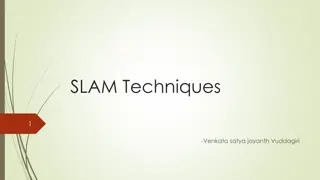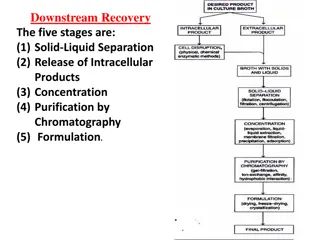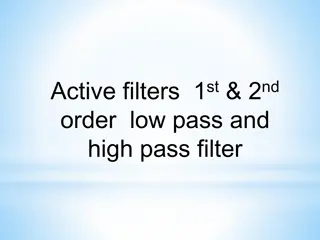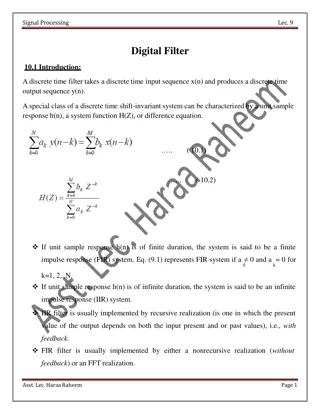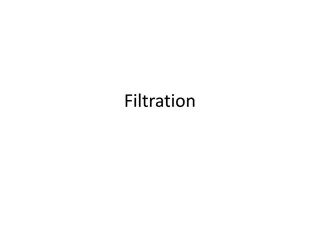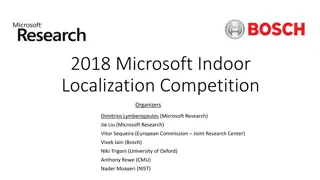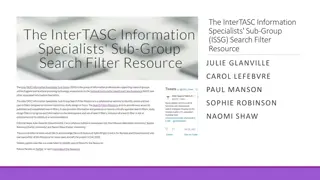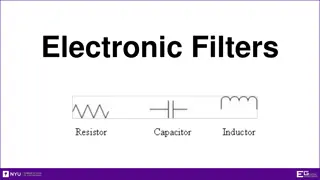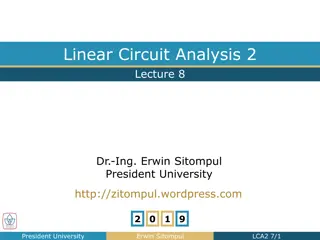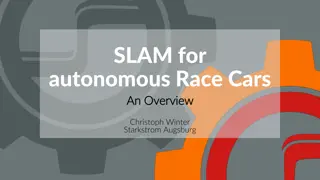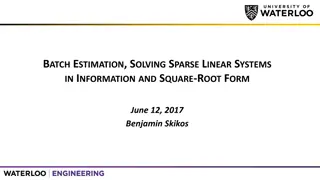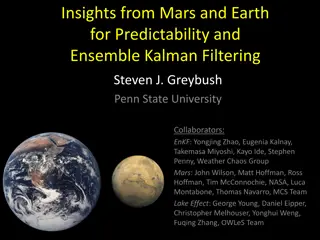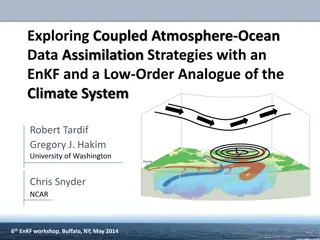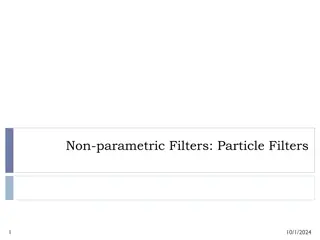Understanding Robot Localization Using Kalman Filters
Robot localization in a hallway is achieved through Kalman-like filters that use sensor data to estimate the robot's position based on a map of the environment. This process involves incorporating measurements, updating state estimates, and relying on Gaussian assumptions for accuracy. The robot's uncertainty in location evolves as it moves and encounters identifiable landmarks like doors. However, challenges arise when the robot is unsure of the specific door it is sensing, highlighting the limitations of Gaussian assumptions in certain scenarios.
Download Presentation

Please find below an Image/Link to download the presentation.
The content on the website is provided AS IS for your information and personal use only. It may not be sold, licensed, or shared on other websites without obtaining consent from the author. Download presentation by click this link. If you encounter any issues during the download, it is possible that the publisher has removed the file from their server.
E N D
Presentation Transcript
Histogram filter Non-parametric Filters 1 10/1/2024
Localizing a Robot in a Hallway consider a robot moving down a hall equipped with a sensor that measures the presence of a door beside the robot the pose of the robot is simply its location on a line down the middle of the hall the robot starts out knowing how far down the hallway it is located Kalman-like filters require an initial estimate of the location robot has a map of the hallway showing it where the doors are 2 10/1/2024
Kalman Localization robot starts out knowing how far down the hallway it is located 3 10/1/2024
Kalman Localization as the robot moves forward, its uncertainty in its location shifts and grows according to its motion model 4 10/1/2024
Grid Localization when it reaches a door that can be uniquely identified, it can incorporate this measurement into its state estimate measurement liklihood updated state estimate 5 10/1/2024
Grid Localization as the robot moves forward, its uncertainty in its location shifts and grows according to its motion model 6 10/1/2024
Gaussian Assumption Kalman-like filters assume that quantities can be represented accurately as a mean + covariance e.g., the state is a random variable with Gaussian distribution e.g., measurements are random variables with Gaussian distribution 7 10/1/2024
Gaussian Assumption assumption is ok here EKF UKF 8 10/1/2024
Gaussian Assumption assumption is (possibly) not ok here EKF UKF 9 10/1/2024
Gaussian Assumption assumption is not ok here (robot does not know which door it is measuring) p(robot is sensing a door | state) 10 10/1/2024
Non-parametric Filters non-parametric filters do not rely on a fixed functional form of the state posterior instead, they represent the posterior using a finite number of values each roughly corresponding to a region (or point) in state space two variations partition state space into a finite number of regions e.g., histogram filter represent the posterior using a finite number of samples e.g., particle filter 1. 2. 11 10/1/2024
Histogram table of frequencies bins 12 10/1/2024
Histogram Filter histogram filter uses a histogram to represent probability densities in its simplest form, the domain of the densities is divided into subdomains of equal size with each subdomain being a bin of the histogram the value stored in the bin is proportional to the density 13 10/1/2024
Histogram Filter suppose the domain of the state x is [-5, 5] and that x is a random variable with Gaussian density (mean 0, variance 1) using bins of width w = 0.1 we can represent the density using the following histogram histogram p height of bar Gaussian PDF n = pdf ( / ) x w , i c i center of bin i i = 1 in x 14 10/1/2024
Histogram Filter suppose we want to pass the density through some non-linear function = 3 ( ) 1 f x x reminder: this is the solution obtained by passing 500,000 random samples through f (x), not the result of using a histogram filter = = , 0 1 15 10/1/2024
Histogram Filter create an empty histogram h with bins xc,i for each i yi = f (xc,i) ni = p(xc,i) find the bin bk that yi belongs in h (bk) = h (bk) + ni 1. 2. 1. 2. 3. 4. 16 10/1/2024
A Simple Implementation dx = 0.05; % width of x bins xc = -5:dx:5; % bin centers x y = nthroot(xc 1, 3); % y = f(xc) n = normpdf(xc, 0, 1); % n = p(xc) dy = 0.1; % width of y bins yc = -2:dy:2; % bin centers y h = zeros(size(yc)); % histogram for i = 1:length(y) bk = find(y(i) > yc (dy / 2) & y(i) < yc + (dy / 2)); h(bk) = h(bk) + n(i); end bar(yc, h, 1); 17 10/1/2024
Histogram Filter alternatively create an empty histogram h with bins xc,i for each bin bk in_bin ) ( ) ( , i 1. 2. = ( , ) h b p x y b 1. k c i i k y = ( ) b f x , i c i in_bin ( , ) y probability that yi is in bin bk i k 18 10/1/2024
Histogram Filter = 3 ( ) 1 f x x = = , 0 1 19 10/1/2024
Grid Localization grid localization uses a histogram filter over a grid decomposition of pose space consider a robot moving down a hall equipped with a sensor that measures the presence of a door beside the robot the pose of the robot is simply its location on a line down the middle of the hall the robot starts out having no idea how far down the hallway it is located robot has a map of the hallway showing it where the doors are grid decomposes the hallway into a finite set of non-overlapping intervals e.g., every 50cm would yield intervals [0, 0.5], (0.5, 1], (1, 1.5], 20 10/1/2024
Grid Localization the robot starts out having no idea how far down the hallway it is located the histogram of its state density is uniform 21 10/1/2024
Grid Localization because the robot is beside a door, it has a measurement it can incorporate this measurement into its state estimate measurement liklihood updated state estimate 22 10/1/2024
Grid Localization as the robot moves forward, its uncertainty in its location shifts and grows according to its motion model 23 10/1/2024
Grid Localization when it reaches a door, it can incorporate this measurement into its state estimate it now has a pretty good idea where it is in the hallway measurement liklihood updated state estimate 24 10/1/2024
Grid Localization as the robot moves forward, its uncertainty in its location shifts and grows according to its motion model 25 10/1/2024
Grid Localization Algorithm algorithm_grid_localization( ) for all k do motion_model( ) measurement_model( ) endfor return } { ,t { }, , , p u z m 1. , 1 k t t t 2. i = = p p p x x mean ( ), , mean ( ) u 3. , , 1 k t i t k t i p x , mean ( ), z m 4. , , k t k t t k 5. k p 6. { } p histogram , k t u control input t z measurement t m map x mean( ) center of mass of grid cell xi i 26 10/1/2024




